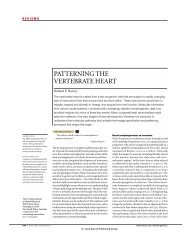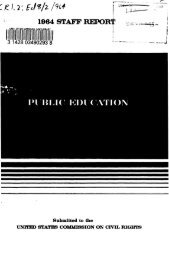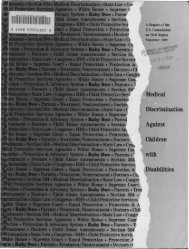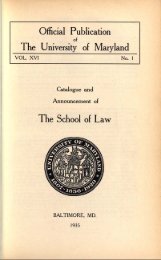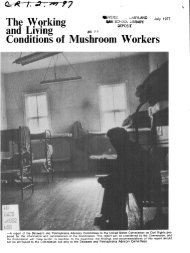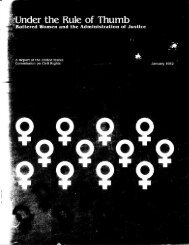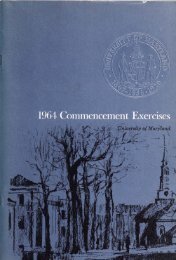1961 US Commission on Civil Rights Report Book 2 - University of ...
1961 US Commission on Civil Rights Report Book 2 - University of ...
1961 US Commission on Civil Rights Report Book 2 - University of ...
Create successful ePaper yourself
Turn your PDF publications into a flip-book with our unique Google optimized e-Paper software.
and the West with similar, or worse, inequalities where less effort is<br />
being made to alleviate them.<br />
Data presented at the <str<strong>on</strong>g>Commissi<strong>on</strong></str<strong>on</strong>g>'s Detroit hearings seemed to show<br />
extreme overcrowding <strong>of</strong> the elementary schools in the predominantly<br />
Negro Center District, as compared with other districts in that city. 73<br />
Detroit school authorities present at the hearings did not protest.<br />
Twenty-three percent <strong>of</strong> the total elementary school populati<strong>on</strong> <strong>of</strong> Detroit<br />
attends school in the Center District. It was reported that: 7 *<br />
Fifteen percent <strong>of</strong> these children sit in classes <strong>of</strong> 40-44 students<br />
per class. This is in comparis<strong>on</strong> to the following percentages <strong>of</strong><br />
children in classes <strong>of</strong> that size in other districts—<br />
East District<br />
Percent<br />
o. 13<br />
North District . 05<br />
Northeast District . 04<br />
Northwest District . 08<br />
South District . 01<br />
Southeast District . 01<br />
West District. . 05<br />
Sixty-two and <strong>on</strong>e-half percent <strong>of</strong> all the children in the city's<br />
elementary schools who sit in classes <strong>of</strong> from 45 to 49 are children<br />
in the Center District.<br />
Does such overcrowding in the predominantly Negro schools <strong>of</strong> the<br />
Center District c<strong>on</strong>stitute unc<strong>on</strong>stituti<strong>on</strong>al inequality?<br />
In the Skipwith case, discussed above, the inferiority <strong>of</strong> the de facto<br />
Negro and Puerto Rican schools was established in terms <strong>of</strong> the inferior<br />
quality <strong>of</strong> their teaching staffs. The New York City practice<br />
<strong>of</strong> permitting teachers <strong>on</strong> tenure to transfer to the schools <strong>of</strong> their<br />
choice appears to be a rather general practice. Without <strong>of</strong>ficial c<strong>on</strong>trols<br />
this too may c<strong>on</strong>tribute to unequal schools.<br />
The <str<strong>on</strong>g>Commissi<strong>on</strong></str<strong>on</strong>g> heard testim<strong>on</strong>y <strong>on</strong> free teacher-transfer practice<br />
at both its California 75 and Detroit Hearings. 78 <strong>Report</strong>s from Philadelphia<br />
suggest a more sophisticated, but perhaps not novel, variati<strong>on</strong>.<br />
For some time that city's board <strong>of</strong> educati<strong>on</strong> has been urged to assign<br />
new teachers in accordance with its own views as to where they can<br />
serve best. But at present teachers may refuse an assignment and still<br />
stay <strong>on</strong> the eligible list. In practice, it is charged, white teachers refuse<br />
assignments to Negro or predominantly Negro schools and, after<br />
the list <strong>of</strong> eligibles has been exhausted, accept appointments to white<br />
or predominantly white schools. The school authorities defend their<br />
positi<strong>on</strong> in permitting this <strong>on</strong> the ground <strong>of</strong> the serious teacher shortage.<br />
They say they cannot afford to drop an applicant from the eligible<br />
list 77 even though the teacher's rejecti<strong>on</strong> <strong>of</strong> the Negro school may re-<br />
114




